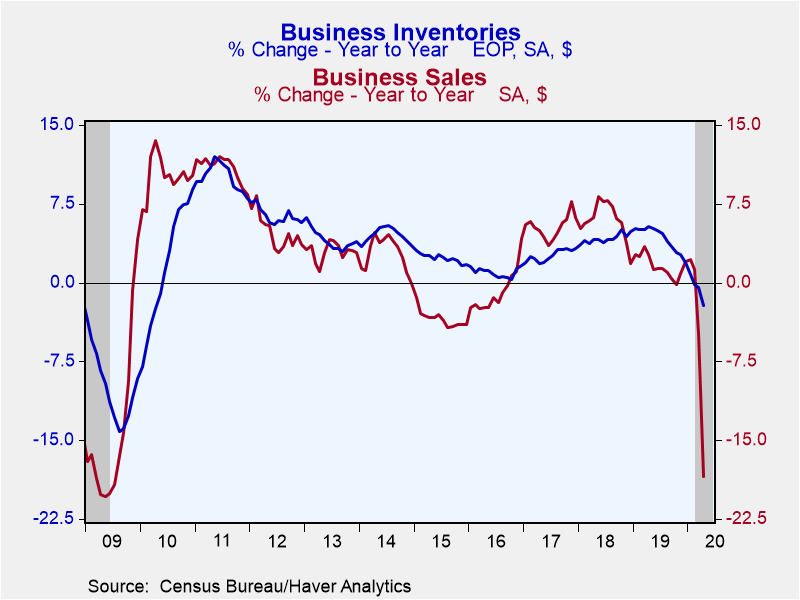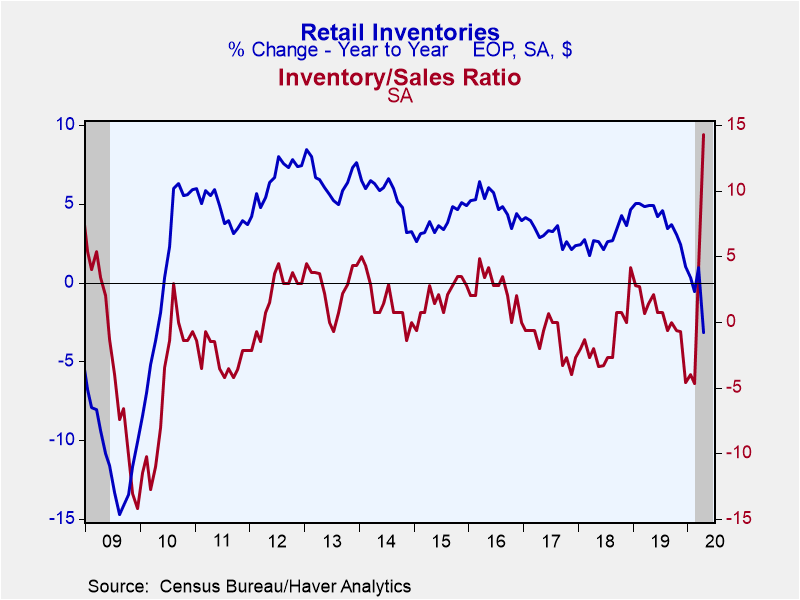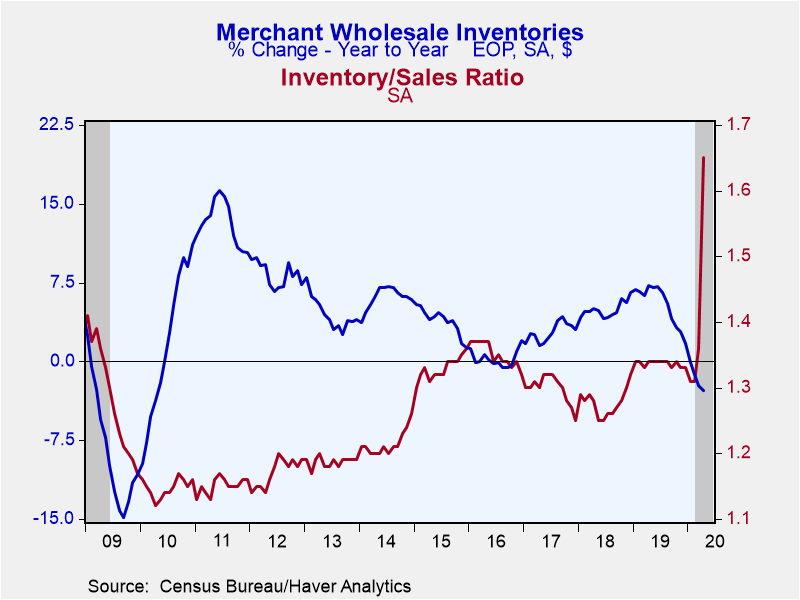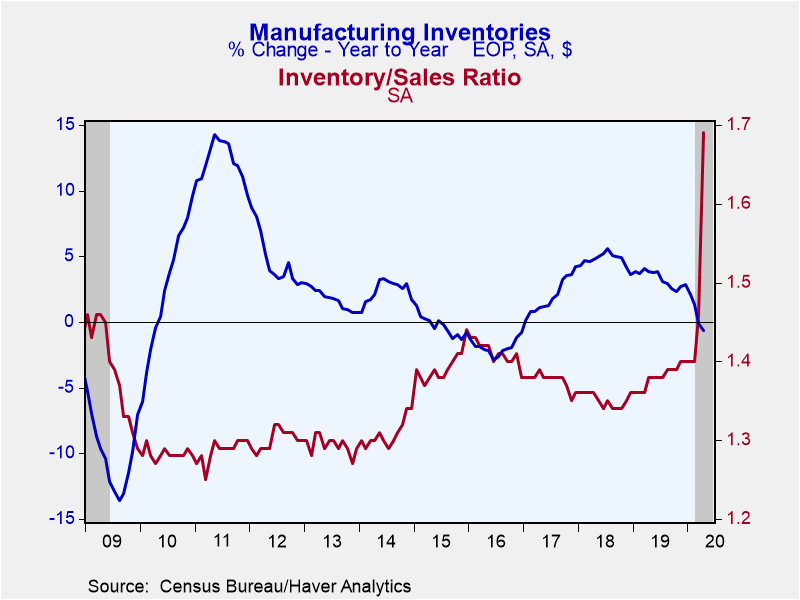 Global| Jun 16 2020
Global| Jun 16 2020Business Inventories Fell as Sales Plunged in April
by:Sandy Batten
|in:Economy in Brief
Summary
Total business inventories fell 1.3% m/m (-2.2% y/y) in April, following a revised 0.3% m/m decline in March. The April decline was larger than the 0.8% decline expected by the Informa Global Markets panel. Business sales collapsed [...]
Total business inventories fell 1.3% m/m (-2.2% y/y) in April, following a revised 0.3% m/m decline in March. The April decline was larger than the 0.8% decline expected by the Informa Global Markets panel. Business sales collapsed 14.4% m/m (-18.4% y/y) in April as the widespread lockdown severely restrained activity. This was by a factor of two the largest monthly decline in sales in the history of the series dating back to 1967. Sales had fallen 5.2% m/m in March as the lockdowns generally began in the second half of the month. Even with the decline in inventories, the huge drop in sales led the inventory/sales ratio to jump up to 1.67 in April, its highest reading since February 1983, from 1.45 in March.
Retail inventories led the overall decline in April, falling 3.7% m/m (-3.2% y/y) after a 1.1% m/m rise in March. The decline in retail inventories was widely spread across major categories with an 8.4% m/m drop in motor vehicle inventories the major contributor. Apart from motor vehicle inventories, other inventories fell a more modest 1.1% m/m (-0.9% y/y) in April. Wholesale inventories edged up 0.3% m/m in April, their first increase in eight months. Manufacturing inventories declined 0.4% m/m in April, their fourth consecutive monthly decline.
Sales plunged at all levels in April. Retail store sales dropped 12.7% m/m (-15.3% y/y). But April sales, also reported separately today, showed a 16.8% m/m rebound in May as some states began to reopen their economies. Wholesale sales collapsed 16.9% m/m in April while manufacturing sales fell 13.5% m/m. The April declines in all three sales categories were by far the largest monthly declines in the series histories.
With sales collapsing, inventory-to-sales ratios soared in April notwithstanding the general decline in inventories. The total I/S ratio shot up to 1.67 in April from 1.45 in March. The retail I/S ratio rose to 1.68 in April from 1.53 in March. The wholesale I/S ratio rose jumped up to 1.65 in April, its highest on record dating back to 1980. The manufacturing I/S ratio increased to 1.69 in April, its highest reading since 1991, from 1.46 in March.
The manufacturing and trade data are in Haver's USECON database and the Informa survey information is in MMSAMER.
| Manufacturing & Trade | Apr | Mar | Feb | Apr Y/Y | 2019 | 2018 | 2017 |
|---|---|---|---|---|---|---|---|
| Business Inventories (% chg) | -1.3 | -0.3 | -0.4 | -2.2 | 1.9 | 4.9 | 3.2 |
| Retail | -3.7 | 1.1 | -0.3 | -3.2 | 1.0 | 4.6 | 2.4 |
| Retail excl. Motor Vehicles | -1.1 | -0.8 | 0.0 | -0.9 | 1.9 | 3.7 | 2.2 |
| Merchant Wholesalers | 0.3 | -1.1 | -0.7 | -2.8 | 1.7 | 6.5 | 3.0 |
| Manufacturing | -0.4 | -1.1 | -0.4 | -0.6 | 2.8 | 3.6 | 4.2 |
| Business Sales (% chg) | |||||||
| Total | -14.4 | -5.2 | -0.5 | -18.4 | 1.6 | 5.9 | 5.3 |
| Retail | -12.7 | -5.1 | -0.5 | -15.3 | 3.4 | 4.2 | 4.6 |
| Retail excl. Motor Vehicle | -12.8 | 1.0 | -0.5 | -10.2 | 3.3 | 5.1 | 4.9 |
| Merchant Wholesalers | -16.9 | -5.1 | -0.7 | -20.7 | 0.6 | 6.8 | 6.6 |
| Manufacturing | -13.5 | -5.5 | -0.4 | -18.9 | 1.0 | 6.6 | 4.7 |
| I/S Ratio | |||||||
| Total | 1.67 | 1.45 | 1.38 | 1.39 | 1.39 | 1.36 | 1.38 |
| Retail | 1.68 | 1.53 | 1.43 | 1.47 | 1.46 | 1.46 | 1.48 |
| Retail excl. Motor Vehicles | 1.35 | 1.19 | 1.21 | 1.22 | 1.22 | 1.22 | 1.24 |
| Merchant Wholesalers | 1.65 | 1.37 | 1.31 | 1.34 | 1.34 | 1.28 | 1.30 |
| Manufacturing | 1.69 | 1.46 | 1.40 | 1.38 | 1.38 | 1.35 | 1.38 |
Sandy Batten
AuthorMore in Author Profile »Sandy Batten has more than 30 years of experience analyzing industrial economies and financial markets and a wide range of experience across the financial services sector, government, and academia. Before joining Haver Analytics, Sandy was a Vice President and Senior Economist at Citibank; Senior Credit Market Analyst at CDC Investment Management, Managing Director at Bear Stearns, and Executive Director at JPMorgan. In 2008, Sandy was named the most accurate US forecaster by the National Association for Business Economics. He is a member of the New York Forecasters Club, NABE, and the American Economic Association. Prior to his time in the financial services sector, Sandy was a Research Officer at the Federal Reserve Bank of St. Louis, Senior Staff Economist on the President’s Council of Economic Advisors, Deputy Assistant Secretary for Economic Policy at the US Treasury, and Economist at the International Monetary Fund. Sandy has taught economics at St. Louis University, Denison University, and Muskingun College. He has published numerous peer-reviewed articles in a wide range of academic publications. He has a B.A. in economics from the University of Richmond and a M.A. and Ph.D. in economics from The Ohio State University.










